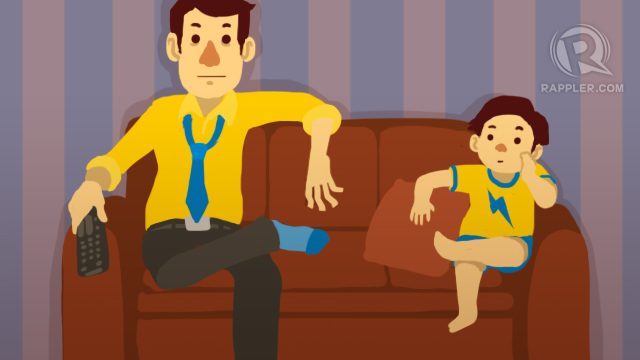SUMMARY
This is AI generated summarization, which may have errors. For context, always refer to the full article.

MANILA, Philippines – Leading an unhealthy lifestyle is a prevalent and growing problem among Filipino adults. However, it’s not always about lack of awareness.
These days, the average commuter spends hours on the road just to get to and from the office. The work schedule of an average employee is 8 to 9 hours a day. Most of that time is spent in front of a desk, typing away on a computer. For many adults, this means barely enough time for sleep and recreation, let alone exercise. As another consequence, meals are chosen and eaten in a hurry, too.
Does the picture above sound familiar? If you find yourself in a similar situation, these circumstances don’t just affect your personal health. Your inactive lifestyle could put your child’s health at risk as well.
Inactive parents, inactive kids
According to studies conducted by the Food and Nutrition Research Institute of the Department of Science and Technology (FNRI-DOST), more school children aged 9 to 12 years old are becoming physically inactive1. In private schools, the prevalence of obesity among children below 10 years old ranges from 25% to 50%. By the time they reach high school, up to 86% of Filipino children are considered physically inactive2.
What causes this worrying trend of inactivity? A major reason cited in the study above was the kids’ sedentary lifestyles, coupled with poor diet choices. Among younger children, the potential to lead a sedentary lifestyle increases as they become more and more accustomed to playing screen-based games, engaging in movie marathons, and communicating with their peers online rather than in person.
As it turns out, parents could be leading this example. According to latest statistics from WeAreSocial, Filipino adults with Internet access spend more time online than the rest of the world – more than 6 hours online on desktop computers and more than 3 hours on mobile devices3. Given the increasing demand for non-stop connectivity, adults may prioritize being online than engaging in physical activities – especially with their families. Does this sound familiar?
When it comes to considering your children’s health, look beyond what they eat and what they do at school. Look at your own habits as well. Are you taking steps to promote an active lifestyle at home? Or are you unconsciously leading them towards an inactive future instead?

Lead by example
Converting to a healthier lifestyle doesn’t happen overnight. But, you can ease into it by starting out with simple steps and strategies:
- Introduce variety into the family’s diet. Children need energy-giving food to sustain their growth and development. If cooking during weekdays takes too much time, prepare healthy meals during the weekend and reheat them when necessary. For baon, avoid giving your child the same processed meats (such as chicken nuggets or cured pork), and sugary, salty snacks and give them more nutritious options such as fresh fruits, vegetable meals, and fortified drinks. When your kids see you enjoying wholesome food, they will be more encouraged to follow your lead.
- Get moving. Find time to inject regular exercise into your daily schedule. Doing some stretching exercises in the morning or walking the last few blocks to your house can make all the difference. In the office, take the stairs instead of the elevator once in a while. When your children see you making an effort to stay fit, they may be encouraged to follow your example.
- Make time for play. While it’s tempting to stay in bed all day during weekends, sacrifice an hour or two of sleep to spend some active time with your kids. Take them to the park, go biking, or simply get moving inside the house. Children only need at least 60 minutes of active play each day to stay healthy! And it will do you a lot of good too.
Being more active today is not just for your own good. It’s for the sake of your child’s healthier and brighter future, too. – Rappler.com
Sources:
1Tanchoco, C. et al. “Assessment of Physical Activity of Some Filipino schoolchildren, Aged 9-12 Years In Selected Public and Private Schools in Metro Manila.” Food and Nutrition Research Institute of the Department of Science and Technology. Available online.
2Javier, Charina. “Eighty-six percent of high school students physically inactive.” Philippine Department of Science and Technology Research and Development Institute. Accessed online, March 2015
3Kemp, Simon. “Digital, Social, and Mobile in 2015.” WeAreSocial Singapore. Accessed online, March 2015.
4_____. ”The AHA’s Recommendations for Physical Activity in Children.” American Heart Association. Accessed online, March 2015.
Add a comment
How does this make you feel?
There are no comments yet. Add your comment to start the conversation.